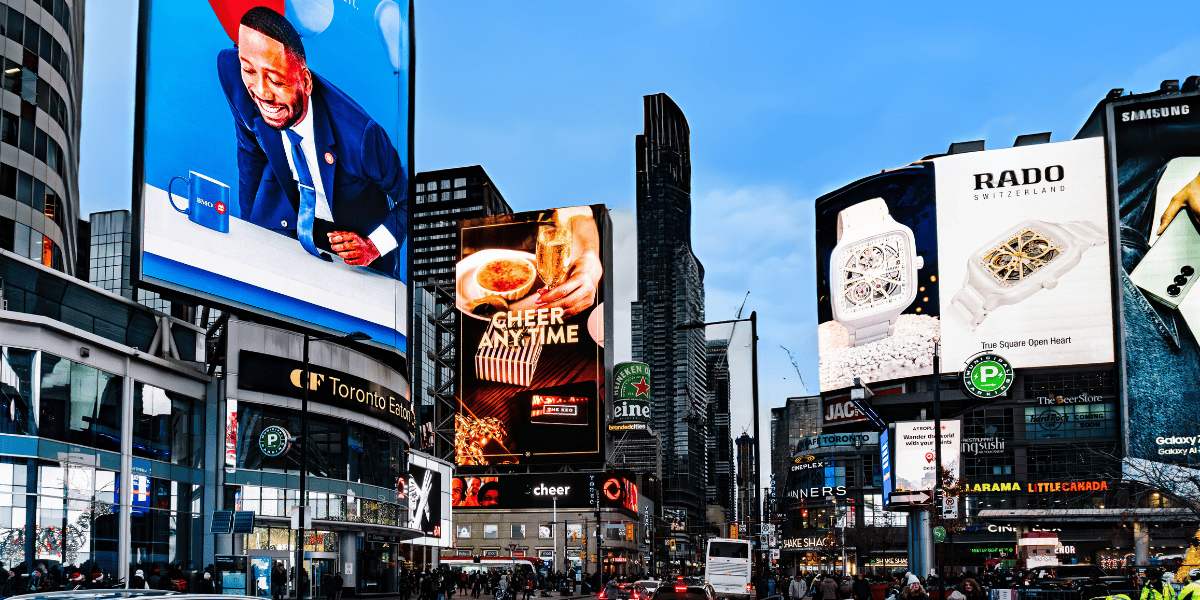
Most marketers are familiar with out-of-home advertising (OOH), but too many write it off in favor of other channels. Labels like “expensive,” “complicated,” “unmeasurable” and “old fashioned” are just a few of the misconceptions we’ve heard over the years. And while it’s true that OOH is one of the oldest forms of advertising, the industry has come a long way since the days when print advertising reigned supreme.
Today, OOH campaigns have evolved into a tech-driven channel that can match the capabilities of your favorite digital channels—from planning to targeting, all the way to measurement. While programmatic digital out-of-home (DOOH) has quickly gained speed, other technological innovations have even made buying traditional out-of-home advertising more efficient.
With these advancements, more brands are realizing the potential of OOH to deliver impactful results. This trend is reflected in global OOH media growth. In 2023, global spending on out-of-home advertising reached $41.9 billion, a 16% increase from 2022’s $36.2 billion, and now exceeds 5% of global ad expenditure—moving forward to the industry target of 10% ad spend share.
Still need to be convinced? In this article, we’re setting the record straight by debunking common myths about OOH advertising and highlighting how marketers can leverage the channel to drive impact.
Myth 1: OOH is too expensive
This is one of the most common myths about OOH advertising. While it’s true that high-impact placements, like large digital billboards or iconic locations, can command a premium price, the truth is that the cost of DOOH advertising can vary depending on the ad’s location, size and campaign flight.
In fact, DOOH advertising can be surprisingly more cost-effective than other media channels, especially for brands looking to reach a large audience. Outdoor advertising campaign formats like billboards, bus shelters, transit ads and point of purchase screens can reach thousands of consumers throughout their daily routines—all at an efficient price.
With programmatic technology, you also have the ability to place ads more frequently across multiple premium locations, rather than just securing a single spot on a high-profile screen. This sustained visibility can reinforce brand recall and engagement without the steep production costs and high CPM typically associated with other media.

Myth 2: OOH is just billboards
When people think about OOH advertising, they often envision billboards. However, DOOH encompasses a much broader range of formats and opportunities. At a high level, this includes:
-
Large format: Media best viewed by drivers, pedestrians or street-level traffic, including billboards, urban panels and bus shelters
-
Place-based media: Contextually relevant analog and digital screens found in malls, gyms, office buildings, gas stations, restaurants, bars, taxis, universities and other locations where consumers regularly spend time
-
Point-of-purchase: A type of placed media, screens that are defined by their placement within a retail location or proximity to a cashier

These interactive and engaging experiences offer unique advantages, from high visibility in key locations to interactive and engaging digital experiences that can captivate consumers along the path of purchase and at the point of sale. By leveraging this wide range of DOOH venue types, brands can tailor their campaigns to effectively reach and influence their target audiences in different settings and contexts.
Learn more: Vistar’s Inventory Catalog
Myth 3: Targeting options are limited
Another myth about OOH advertising is that it lacks the sophisticated targeting capabilities required to reach the right audience. In reality, the most savvy marketers use DOOH in conjunction with other advertising channels to create highly targeted and effective omnichannel campaigns.
Using anonymized GPS location data, brands can define and activate audiences based on the locations consumers visit, enabling them to expand their reach and reinforce the messaging of their campaign. Through geospatial data analysis, marketers can understand when and where their target segments are most likely to be throughout their day.
Programmatic technology also enhances targeting capabilities beyond time and location data. Brands can layer in first- and third-party data to reach their target audience more precisely. With Vistar, for example, marketers can create their own audiences using first-party data from their CRM of choice, or utilize one of Vistar’s data partners, such as Foursquare and Epsilon, for behavioral and demographic targeting.

Myth 4: Personalization is not possible
Data has made personalization a crucial part of advertising, with brands increasingly focused on creating tailored experiences for consumers. However, there’s a common misconception that OOH falls short in this area. In reality, DOOH has evolved to offer dynamic creative capabilities that bring relevant, targeted and effective messaging to your audience at scale. This technology uses data to adjust specific elements within an ad—such as product images, taglines, ad copy and offers—to create more contextually relevant and memorable experiences. Since DOOH uses a one-to-many format for personalization, this also allows you to avoid the sense of intrusiveness that can come with more direct advertising methods.
In reality, DOOH has evolved to offer dynamic creative capabilities that bring relevant, targeted and effective messaging to your audience at scale. This technology uses data to adjust specific elements within an ad—such as product images, taglines, ad copy and offers—to create more contextually relevant and memorable experiences. Since DOOH uses a one-to-many format for personalization, this also allows you to avoid the sense of intrusiveness that can come with more direct advertising methods.
.png?width=960&height=502&name=Myths%20blog%20collage%20(1).png)
Myth 5: There are more automated and flexible advertising options
While there are clear benefits to traditional out-of-home, historically, it has been less suited for campaigns requiring quick turnarounds and frequent variations due to its reliance on hands-on management for placements, creative updates and logistics coordination. The gap between traditional OOH and digital advertising is narrowing thanks to recent tech advancements. With Adstruc, Vistar offers an automated traditional OOH planning and buying tool.
Additionally, when buying DOOH programmatically, you can access the same level of automation as other digital platforms. This automation gives you the flexibility to launch campaigns quickly, adapt to trends and break news quickly. You can also monitor performance and analyze data in real time, allowing you to tweak your messaging, adjust creative elements and fine-tune your targeting as your campaign runs.
And when you buy DOOH programmatically, you get the same level of agility as with any digital channel. You can launch quickly, pivot with trends, and even break news in real time. Plus, real-time performance data means you can adjust messaging, refresh creative, and fine-tune targeting while your campaign is live—no more set-it-and-forget-it.
While traditional out-of-home has its strengths, it hasn’t always been ideal for fast-moving campaigns that need quick turnarounds or frequent creative changes. That’s because it typically relies on manual processes for placements, updates and overall execution. But thanks to new technology, that gap between traditional OOH and digital media is quickly closing. With Adstruc, Vistar brings automation to traditional OOH planning —making the process faster, easier and more scalable.
Myth 6: OOH only drives awareness, but you can't measure the ad campaigns
Traditionally seen as a top-of-funnel channel, OOH was valued for its broad reach and brand-building power. But today, it’s doing much more. OOH has evolved into a full-funnel force, influencing every stage of the customer journey. Elements like dynamic creative, QR codes and point-of-sales inventory allow brands to drive quicker action and guide consumers further along the path to purchase.

In addition, advanced measurement solutions now enable advertisers to track and assess a range of results, including brand health, incremental foot traffic, online conversions and sales lift. With insight into how your DOOH campaigns influence both upper- and lower-funnel metrics, you can more effectively integrate DOOH into your omnichannel strategy, demonstrating its impact beyond awareness and optimizing its role in driving strong campaign results.
How OOH ads are a key part of the advertising industry
Incorporating DOOH into your omnichannel strategy is not as complicated as you may have originally thought! In fact, it can be a cost-effective way to reach your target audience, boost your visibility and drive results at scale. Now that you know the truth about OOH advertising, it’s time to bring your creatives to the real world. Have any questions? Want to discuss new campaign ideas? Get in touch with us today!



